|
Catch A Fire...
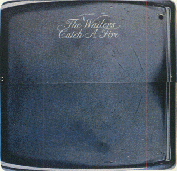 Bob
flew back to England by the end of '72 with the master
copies of "Catch A Fire" and Blackwell began
to put the final touches to it, to make it appeal to
a rock audience. The original album sleeve was in the
shape of a Zippo lighter which when opened revealed
there was a cutout flaming wick with the record hiding
behind it. Bob
flew back to England by the end of '72 with the master
copies of "Catch A Fire" and Blackwell began
to put the final touches to it, to make it appeal to
a rock audience. The original album sleeve was in the
shape of a Zippo lighter which when opened revealed
there was a cutout flaming wick with the record hiding
behind it.
Bob Marley and The Wailers appearing on UK televisions
Old Grey Whistle Test, Performing Concrete Jungle from
the Catch A Fire album, in 1973The first true reggae
album "Catch A Fire" was released in the UK
in December '72 and the US shortly afterwards. Although
the album wasn't a huge seller despite some great reviews
in the UK and US it had justified Blackwell's faith
in the Wailers.
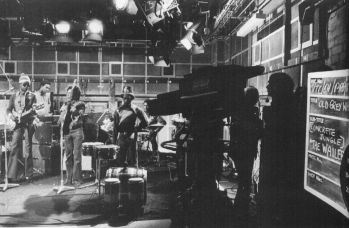 To
support the album the Wailers criss-crossed the UK performing
mainly clubs and small provincial theaters (including
an appearance on UK television's Old Grey Whistle Test)
and then later the US a first for a reggae band. To
support the album the Wailers criss-crossed the UK performing
mainly clubs and small provincial theaters (including
an appearance on UK television's Old Grey Whistle Test)
and then later the US a first for a reggae band.
Despite the success they were having Bunny was becoming
very uncomfortable with life on the road (particularly
when he found it hard to find I-tal, unprocessed food),
and so when the group got back to Jamaica before starting
their US tour, he told Bob that he would continue studio
work and Jamaican gigs, but refused to tour outside
of Jamaica, evectively leaving the Wailers. The US tour
began early in July taking in Boston, New York, the
mid-west, Florida and finally California. Their old
tutor Joe Higgs took bunny's place.
Blackwell realized he needed a follow up album to "Catch
A Fire", and by mid-November of the same year "Burnin"
was released and again, was well received by music fans
who appreciated the rootsier feeling to it. The album
featured reworkings of "Small Axe" and "Duppy
Conqueror" and some new songs such as "I shot
the sheriff", Burnin and Lootin" and the classic
"Get Up Stand Up" written by both Bob and
Peter, it would later be a regular in-concert for Bob.
Sadly it was to be the last album the original trio
(Bob, Bunny and Peter) would work together on. Peter
was becoming uncomfortable with the idea of Bob being
seen as the star of the band (mostly by Island records,
Chris Blackwell), and so left the group and started
his own solo career.
From that point on it would be Bob Marley and Wailers.
TOP Hope Road...
Most of '74 was spent at 56 Hope Road (a house which
had been bought for Bob in upper-class Kingston by Chris
Blackwell), writing songs for the Wailers next album,
and trying to formulate a new structure for the band,
now that Bunny and Peter had left. Bob needed someone
to replace the harmonies of the two, and he found three
woman of such voice: Rita, Bob's wife, and her friend
Marcia Griffiths and Judy Mowatt. They would become
known as the I-threes. Bob had also found a new manager
named Don Taylor who remained so right up to early 1980.
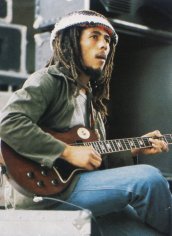 The
Wailers next album was released (after some delays)
early in '75 which was easily Bobs greatest album release
so far, thanks to a cover version of "I Shot The
Sheriff" from the previous album "Burning"
done by famous rock singer Eric Clapton, the song had
gone to no 1 in the US and reached no 9 in the UK, calling
attention to the song writing abilities of the little
known (to most anyway) reggae singer. The
Wailers next album was released (after some delays)
early in '75 which was easily Bobs greatest album release
so far, thanks to a cover version of "I Shot The
Sheriff" from the previous album "Burning"
done by famous rock singer Eric Clapton, the song had
gone to no 1 in the US and reached no 9 in the UK, calling
attention to the song writing abilities of the little
known (to most anyway) reggae singer.
The album contained some of Bob's best know songs like
the classic "No Woman, No Cry", "Lively
Up Yourself", "Rebel Music", and "Them
Belly Full (But We Hungry)" among others.
Yet again another tour was organized in North America
by the summer of '75, then by mid-July flew to England
for another 4 dates (at larger venues) including two
consecutive nights at London's Lyceum the second of
which Chris Blackwell recorded for a live album.
Even though Bob had now become an international success
he never let it go to his head and he remained true
to his beliefs, and considered himself as merely a messenger
of Jah Rastafari.
"Me only have one ambition," he asserted, "
I only have one thing that I like to see happen, I
like to see mankind come together - black, white,
Chinese, everyone - that's all..."
By August Bob was back in Jamaica working on songs
for the next album. One song in particular he was working
on was a speech that Haile Selassie had delivered to
a United Nations assembly at Stanford University in
California in 1968, which would be titled "War".
The song became one of Bob's most powerful highlights
of the Wailers stage show.
"Until the philosophy which holds one race superior
and another inferior,
is finally and permanently discredited and abandoned,
me say War" It was during these sessions that Jamaican newspapers
were reporting that Haile Selassie had died. As soon
as Bob had heard the news he set about writing a new
song entitled "Jah Live" which was Bobs way
of expressing to the non-believers that you cant kill
God.
"Fools say in their heart, Rasta your God is dead,
but I'n'I know Jah Lives..." On its release in Jamaica the song was an instant success.
Bob new manager Don Taylor had set up a show that would
be known as the Dream Concert. When the Rock star Stevie
Wonder was asked to play, with the idea of headlining
a joint stadium concert (with the Wailers) with the
profits to go to a Jamaican Salvation Army Institute
for the Blind he happily agreed to play.
The Concert took place on October 11 with both Peter
and Bunny joining the Wailers set, this was to be the
last time that the 3 would perform together on stage.
The show was a huge success with the highlight being
when Stevie Wonder joined in on singing "I Shot
the sheriff" at the end of the Wailers set. It
highlighted the fact that Bob Marley and the Wailers
were now an international success.
TOP
Rastaman Vibration...
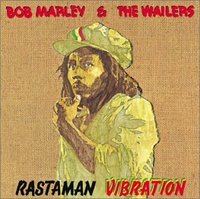 It
was May '76 that Rastaman Vibration was released. With
most of the songs being regular in-concert songs. The
album contained ten songs in all, Positive vibration,
Roots, Rock, Reggae, Crazy Baldheads, are a few, with
the highlights being "War" and "Rat Race".
The later being a song about the upcoming elections
in which Bob reminds the listener that "Rasta don't
work for no CIA." It
was May '76 that Rastaman Vibration was released. With
most of the songs being regular in-concert songs. The
album contained ten songs in all, Positive vibration,
Roots, Rock, Reggae, Crazy Baldheads, are a few, with
the highlights being "War" and "Rat Race".
The later being a song about the upcoming elections
in which Bob reminds the listener that "Rasta don't
work for no CIA."
A three-month tour of North America and Europe began.
A show in Philadelphia at the Tower Theater would give
Bobs Mother a chance to see her son perform a live concert
for the first time, having been driving up from Delaware
especially for the show. Bob played an extra long show
(knowing his Mom was in the audience). She was very
impressed with the performance (which is also one of
my favorites and I'm sure many other people too), as
were the other thousands present with her in the crowd.
The Wailers moved to Europe after the Californian shows,
these included dates in Germany, Amsterdam, Paris and
finally England.
When Bob returned to Jamaica in September, he found
it to be a war zone - literally.
On the run up to the elections which were to be held
on the 15 of December 1976, Bob was asked to play a
concert on the 5th to "cool down" the waring
sides of the two main political paties the PNP and the
JLP, at least until the elections were over. Bob agreed
to play.
TOP
Ambush in the night...
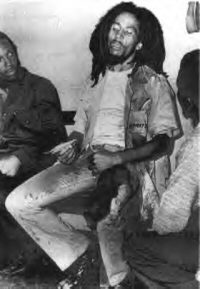 On
December 3rd, two nights before the Smile Jamaica concert
gunmen entered the back room of Bobs house, where Bob
and members were reharsing for the show. The gunmen
opened fire, showering the room with bullets, hitting
Bob in the arm, Rita was shot by one of two men in the
front yard as she ran out of the house with the Marley
children and a reporter from the Jamaican Daily News.
The bullet caught her in the head, and burrowed between
the sclap and skull. On
December 3rd, two nights before the Smile Jamaica concert
gunmen entered the back room of Bobs house, where Bob
and members were reharsing for the show. The gunmen
opened fire, showering the room with bullets, hitting
Bob in the arm, Rita was shot by one of two men in the
front yard as she ran out of the house with the Marley
children and a reporter from the Jamaican Daily News.
The bullet caught her in the head, and burrowed between
the sclap and skull.
Don Tailor, Bob's manager was just coming into the
room to speak to Bob, and steped right in the line of
fire. As Talylor lay in a heap on the floor in front
of Bob, bleeding badly from several bullets lodged in
his upper thighs and another at the base of his spine
he didn't realize that he had been directly in the line
of gunfire meant for Bob. The gunmen fired a total of
eight shots in the room, one bullet hitting a counter,
another hit the ceiling, five tore into Don Talor and
the last creased Marleys breast below his heart and
lodged deep inside his arm.
Bobs friend Lewis Griffith also needed immediate medical
attention for his stomach wounds.
The injured were rushed to hospital as soon as the
smoke cleared, where Bob got treated for his wound.
Taylor and Griffith were put on the critical list, Rita
went into surgery for the removel of the bullet lodged
in her sclap.
Amazingly no one was killed in the incident.
Bob retreated, under police escort to a hideout in
the Blue montains over-looking Kingston, where he got
time to reason with his Rasta brethren about the Ambush
that just took place, and the question of the Wailers
appearance at the Smile Jamaica show was left to linger.
By the day of the show all of Jamaica had heard of
the shooting incident and although Marley was not expected
to appear; the crowd that day began building, and by
5pm there 50,000 had gathered.
Bob decided to appear despite the fact that he would
be leaving himself open for further attacks.
Bob made his way down the narrow montain road to the
festival site (which had now grown to 80,000) escorted
by police and orther members of the band, including
Rita, who had joined Bob after being released from hospital.
Bob met the leader of the PNP, Michael Manley on stage
who hugged him with emotion and then stepped on to the
sideline.
Bob started the show by saying "When me decide
ta do dis yere concert two anna half months ago, me
was told dere was no polictics. I jus wanted ta play
for da love of da people." Then saying he would
sing "one song" he launched into what became
a ninety-minute set, starting with the song "War".
Near the end of his peformance Bob opened his shirt
and rolled up his left sleeve to show his wounds to
the audience. Before leaving the last thing the crowd
witnessed was Bob mimicking the gunmen with his hand
drawn out in the shape of a gun, with his locks thrown
back in the air.
"When people start fighting
me, is more better fer me. Me can sit down an' meditate
off what they's fighting me for and write a song about
it...
'Ow ya think me write I Shot the Sheriff?"
TOP
Exodus...
In the months that followed, Bobs whereabouts were
unknown to most. It was 3 months later when Bob traveled
to England (were his presence was discovered when he
was caught for possessing ganja) to start work on his
next album, which was titled "Exodus" and
subtitled Movement of Jah People.
While in England he stayed with a Jamaican beauty Queen,
and later Miss World, Cindy Breakspeare, who had a child
with Bob (Damian Marley). It was while in England that
Bob gained a lot of fame thoughout England and Europe.
The "Exodus" album was released in May 1977
and was his most successful album yet, reaching no 8
in the UK charts.
REPORTER: You think the whole question of fame, what
it's done to you, is part of you belongs to that world
of music. You think that's gonna change your beliefs
and effect you?
BOB: Ya can't do that ta me! Any body change, they
change from long time ago. They have that change within
them; whatever you see - it was there before. 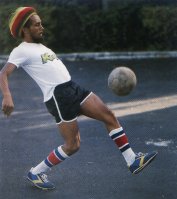 A
European tour was organized to promote the album. The
start off venue was Paris, where Bob and crew took time-off
for a football match against a tough-tackling team of
French journalists. A
European tour was organized to promote the album. The
start off venue was Paris, where Bob and crew took time-off
for a football match against a tough-tackling team of
French journalists.
During one of these tackles Bobs right big toe was
crushed, which sent him limping off the pitch. Despite
first aid it proved impossible for the wound to heal
up properly due to conditions of life on the road and
on stage.
The tour had taken the group through Belguim, Holland,
Germany and Scandininavia before coming back to Britain
in June; Bob had toured despite the permanent pain due
to his big toe not healing properly.
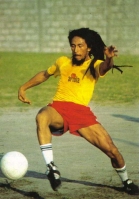 Apart
from his music, Bob's favorate past time was football.
When the tour ended Bob saw a foot specialist in London,
who after close examination of the toe discorvered cancer
cells. The doctor recommended that the entire toe be
amputated as early as possible in order to stop the
spread of the cells. Apart
from his music, Bob's favorate past time was football.
When the tour ended Bob saw a foot specialist in London,
who after close examination of the toe discorvered cancer
cells. The doctor recommended that the entire toe be
amputated as early as possible in order to stop the
spread of the cells.
The suggestion that Bob should lose part of his foot
shocked him, probably even more so then the discovery
of cancer. Unsure what do to Bob went to Miami to get
a second opinion, visiting the surgeon who had saved
Don Taylor's life after the ambush the year before.
The advice he gave Bob was the same, some of the injured
toe at least would have to go, so Bob had the operation
done to remove the toenail and had the toe cleansed
and it healed beautifully as a result.
TOP Kaya...
The period of rest that followed the procedure was
spent mainly in Miami, were Bob was inspired to write
an album called Kaya. The word "Kaya" being
the Jamaican term for ganja. The album was released
by the spring of 78, it was a series of uplifting songs
about the simple things in life, like a misty morning
- sun is shining -the pleasures of smoking herb - making
love. The album also contained one of Bobs best known
songs "Iis this Love?". The critics accused
Marley of "going soft" saying that he had
given up his leadership role. Marley simply stated that
he "Jus' wanna cool off the pace."
Bobs manager Don Taylor who was now fully recovered
from the shooting incident almost two years earlier,
began to plan a Wailers world tour. Based around the
recently released Kaya album, the tour was planned to
start in the US in May before covering Europe in the
summer and eventually Australia, New Zealand and Japan
during the autumn.
TOP
To read the final part of this biography of Bobs Marleys
life, CLICK
HERE
|

 Bob
flew back to England by the end of '72 with the master
copies of "Catch A Fire" and Blackwell began
to put the final touches to it, to make it appeal to
a rock audience. The original album sleeve was in the
shape of a Zippo lighter which when opened revealed
there was a cutout flaming wick with the record hiding
behind it.
Bob
flew back to England by the end of '72 with the master
copies of "Catch A Fire" and Blackwell began
to put the final touches to it, to make it appeal to
a rock audience. The original album sleeve was in the
shape of a Zippo lighter which when opened revealed
there was a cutout flaming wick with the record hiding
behind it. To
support the album the Wailers criss-crossed the UK performing
mainly clubs and small provincial theaters (including
an appearance on UK television's Old Grey Whistle Test)
and then later the US a first for a reggae band.
To
support the album the Wailers criss-crossed the UK performing
mainly clubs and small provincial theaters (including
an appearance on UK television's Old Grey Whistle Test)
and then later the US a first for a reggae band. The
Wailers next album was released (after some delays)
early in '75 which was easily Bobs greatest album release
so far, thanks to a cover version of "I Shot The
Sheriff" from the previous album "Burning"
done by famous rock singer Eric Clapton, the song had
gone to no 1 in the US and reached no 9 in the UK, calling
attention to the song writing abilities of the little
known (to most anyway) reggae singer.
The
Wailers next album was released (after some delays)
early in '75 which was easily Bobs greatest album release
so far, thanks to a cover version of "I Shot The
Sheriff" from the previous album "Burning"
done by famous rock singer Eric Clapton, the song had
gone to no 1 in the US and reached no 9 in the UK, calling
attention to the song writing abilities of the little
known (to most anyway) reggae singer. It
was May '76 that Rastaman Vibration was released. With
most of the songs being regular in-concert songs. The
album contained ten songs in all, Positive vibration,
Roots, Rock, Reggae, Crazy Baldheads, are a few, with
the highlights being "War" and "Rat Race".
The later being a song about the upcoming elections
in which Bob reminds the listener that "Rasta don't
work for no CIA."
It
was May '76 that Rastaman Vibration was released. With
most of the songs being regular in-concert songs. The
album contained ten songs in all, Positive vibration,
Roots, Rock, Reggae, Crazy Baldheads, are a few, with
the highlights being "War" and "Rat Race".
The later being a song about the upcoming elections
in which Bob reminds the listener that "Rasta don't
work for no CIA." On
December 3rd, two nights before the Smile Jamaica concert
gunmen entered the back room of Bobs house, where Bob
and members were reharsing for the show. The gunmen
opened fire, showering the room with bullets, hitting
Bob in the arm, Rita was shot by one of two men in the
front yard as she ran out of the house with the Marley
children and a reporter from the Jamaican Daily News.
The bullet caught her in the head, and burrowed between
the sclap and skull.
On
December 3rd, two nights before the Smile Jamaica concert
gunmen entered the back room of Bobs house, where Bob
and members were reharsing for the show. The gunmen
opened fire, showering the room with bullets, hitting
Bob in the arm, Rita was shot by one of two men in the
front yard as she ran out of the house with the Marley
children and a reporter from the Jamaican Daily News.
The bullet caught her in the head, and burrowed between
the sclap and skull. A
European tour was organized to promote the album. The
start off venue was Paris, where Bob and crew took time-off
for a football match against a tough-tackling team of
French journalists.
A
European tour was organized to promote the album. The
start off venue was Paris, where Bob and crew took time-off
for a football match against a tough-tackling team of
French journalists. Apart
from his music, Bob's favorate past time was football.
When the tour ended Bob saw a foot specialist in London,
who after close examination of the toe discorvered cancer
cells. The doctor recommended that the entire toe be
amputated as early as possible in order to stop the
spread of the cells.
Apart
from his music, Bob's favorate past time was football.
When the tour ended Bob saw a foot specialist in London,
who after close examination of the toe discorvered cancer
cells. The doctor recommended that the entire toe be
amputated as early as possible in order to stop the
spread of the cells.